Aerial
Lift
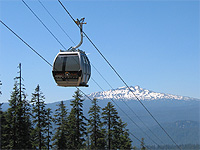 |
Any
lift in which skiers are transported while suspended off
the ground, as opposed to surface lifts, which move skiers
and snowboarders up the hill while their skis or boards
are in contact with the snow. Aerial lifts include chairlifts,
gondolas and trams. |
Anti-rollback
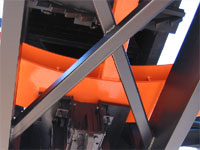 |
A
mechanical system which prevents the weight of passengers
on a lift from making the lift roll backwards in the event
of engine or gearbox failure. Some modern lifts are designed
to run in reverse for special purposes. |
Auxiliary
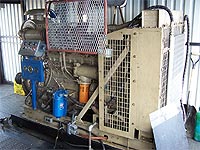 |
A
gasoline or diesel engine which allows the lift to run in
the event of power failure or problem with the main motor. |
Guide
Rail
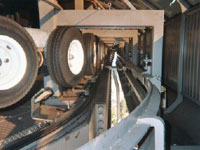 |
A
guidance rail which high speed detachable lifts have that
stabilize the carrier as it enters and moves around the
terminal. |
| BreakoverCord
Angle
|
difference in cord angles between towers. Also called breakover angle. |
Brittle
Bar
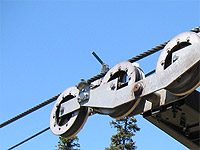 |
One
of several devices used to detect a cable coming off the
sheave wheels, a brittle bar is a metal bar connected to
a safety circuit. Should the cable come off the sheave wheel,
it strikes a brittle bar, breaking it. The interruption
of the circuit causes the lift to stop. They are also used
to detect overtravels on counterweights and to check proper
positioning of certain grip components while passing through
lift terminals. (see also Rope Position Detector). |
Brittle
(Break) Fork
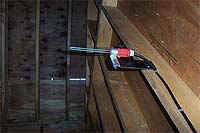 |
The
one in the picture are to stop the lift in case the counterweight
is lifted to high, basically if anything comes into contact
with them, they break - causing the safety circuit to open
and the lift to stop. |
Bullwheel
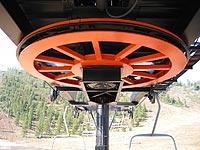 |
Large-diameter
metal wheels used to change the direction of a haul rope.
They're found at the top and bottom lifts. |
Cable
Catcher
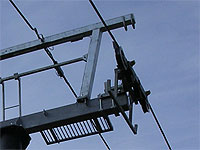 |
A
metal protruberance on the sides of sheave trains which
catches the haul rope and prevents it from dropping to the
ground, in the unlikely event that the haul rope comes off
the sheave wheel. |
Cabriolet
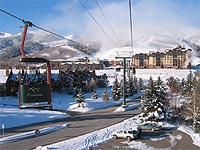 |
Mechanically
and operationally, Cabriolet lifts are nearly identical
to gondolas. The principal difference is that the carriers
(cabins) are open, and passengers stand rather than sit.
They tend to be rather short and are used primarily as "people
movers," rather than to take skiers to the top. A Cabriolet
lift was installed at The Canyons in Utah for the 2000-2001
season. |
Capacity
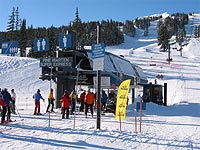 |
Typically,
this refers to the number of people who can board or disembark
over a given period of time (typically one hour). Because
of the speed with which skiers and snowboarders can successfully
move up to the load line and/or safely disembark, capacity
is typically limited on the upper end by the frequency with
which carriers move through the terminals. (see Carrier
Spacing). Current upper limits on double chairlifts is about
1200 persons per hour (2 persons every six seconds, which
is twenty persons per minute, or 1200 per hour). Similarly,
triple chairs have an approximate limit of 1800 per hour;
and fixed grip quads can handle a maximum of 2400 per hour.
Because detachable lifts (including detachable quads, six
packs and gondolas) can actually have more than one carrier
undergoing the load process at once, detachable lifts can
load more than 3,000 per hour. See also: VTFH (Vertical
Transport Feet per Hour). |
Carrier
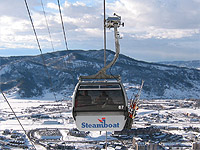 |
A
generic term for the device on or in which customers ride.
They can be chairs, gondola cabins, tram cabins, T-bars,
etc. |
Carrier
Spacing
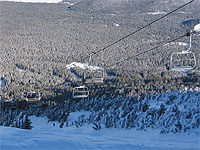 |
Can
refer to either the time interval between carriers as they
move through the terminal or the distance between carriers
themselves. Typically, fixed grip lifts send a carrier past
the load line every six seconds or so - a "six second"
spacing. When used to describe distance, refers to the linear
distance between the carriers. The design spacing is maintained
on detachable lifts by means of a device called a spacer. |
Catenary
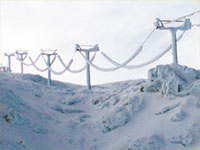 |
The
sag in the haul rope between towers. |
Compression
Assemblies
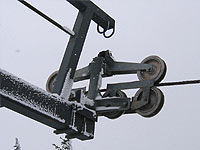 |
Compression
Assemblies: An assembly of sheaves that support and holds
down the haul rope. This type of assembly controls the haul
rope for both positive and negative loads. This assembly
is common in steeper spans with little slope change and
at loading towers. Also called trap assembly. |
Chairlift
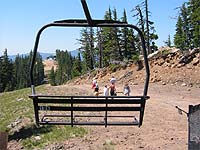 |
Any
form of open lift in which passengers sit in a chair while
being transported. Some chairlifts have "bubbles,"
or fiberglass shells, which can be pulled down to protect
passengers from inclement weather. |
Comm
Line or Communications Cable
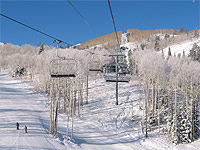 |
This
is the cable you generally see running down the middle of
the lift, supported on the lift frame of the tower head.
The comm line carries the data signals from each tower's
safety and operating circuitry, as well as phone lines between
the base, summit and mountain dispatch. |
Conveyor
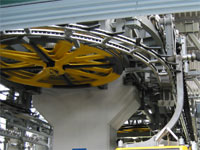 |
A
system consisting of a track and drive system which transports
carriers through the terminal on a detachable lift (gondolas,
detachable chairlifts). Conveyors are usually powered by
power takeoff wheels driven by the haul rope, to ensure
that carrier spacing remains constant. |
Cord
Angle
|
The
change of angle between the slope of the haul rope and horizontal;
measured at the tower cross arm. |
Counterweight
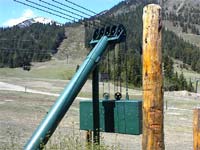 |
A
massive weight at either the top or bottom of a lift, attached
to the bullwheel, which keeps correct amount of tension
on the haul rope - and therefore, the appropriate amount
of friction between the haul rope and the wheel. Many new
lifts are tensioned by either pneumatic or hydraulic tensioning
systems instead of counterweights. |
Crossarm
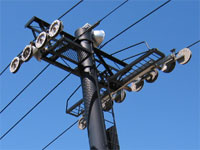 |
The
horizontal arm on top of a tower, to which the sheave wheels
are attached. |
Detachable
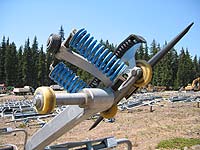 |
A
lift (gondola, chairlift) which detaches from the haul rope
to go through the terminals. This process allows carriers to
move slowly through the terminals, making it easier to get on
and off, and travel rapidly on the line, giving skiers and snowboarders
a fast lift ride. (See GRIP).
Left: Picture of a detachable grip (Garaventa
AK 400) |
Down-Line
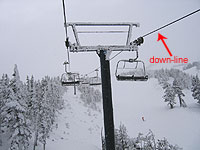 |
The
side of the lift that the haul rope goes down the hill. |
Download
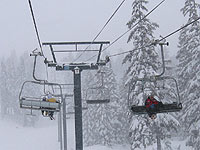 |
The
process of letting passengers ride down the lift, instead
of up it. Many lifts are limited in their download capacity;
others can transport passengers at 100 percent capacity
in either direction. |
Drive
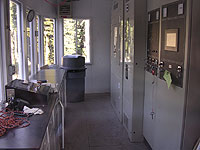 |
The "brains" of the lift. The drive is the electronic
circuitry which controls the amount of voltage sent to the
primary motor of the lift and controls its speed. Modern
lifts are powered by Direct Current, controlled by the drive,
which allow them to operate very smoothly and efficiently.
The drive is also tied in with all of the lift's inline
safety circuitry, which shuts down the lift automatically
in the event of a problem on the line or in one of the terminals. |
Drive
Terminal
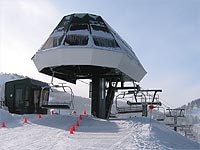 |
The
terminal which houses the motor, gearbox, auxiliary engine
and drive and safety circuitry. It can be at either the
top or the bottom of the lift ("top drive," "bottom
drive.") A top drive lift is slightly more energy efficient
than a bottom drive lift, but requires the ski area to run
electric service to the summit, which can be very costly. |
E-Brake
or Emergency Brake
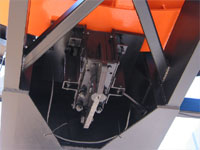 |
A
brake which is used in emergencies to help stop the lift
in case of a roll back or something drastic will happen.
The brake is pressed up against the bullwheel which stops
the lift with great force. |
Funicular
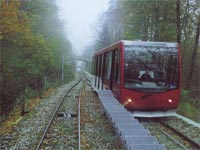 |
A
type of lift which uses a car traveling on steel rails,
as a carrier. Most funiculars are "jigback" lifts,
meaning that the weight of a car coming down counterbalances
the weight of a car going up. Some funiciulars use two tracks,
and some use just one, switching into two tracks in the
middle of the line to allow the cars to pass. Most funiculars
are in Europe. There are no funiculars at any North American
ski areas, although there are several in urban settings
(including Pittsburgh, PA and Quebec City). |
Funitel
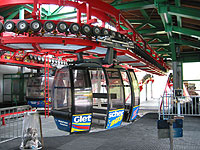 |
A comparatively new type of lift which is essentially a
dual-monocable gondola with large cabins. The dual ropes
make the Funitel capable of long spans between towers and
makes the cabin less susceptible to wind. Only a handful
have been built, mostly in Europe. |
Gearbox
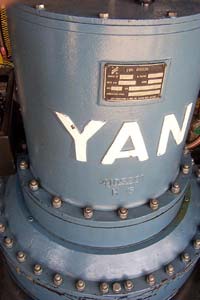 |
The lift's transmission. The gearbox takes power from the
motor or auxiliary and transfers it to the bullwheel at
the drive terminal. |
Gondola
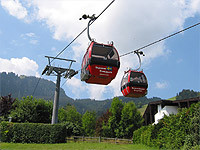 |
A
type of lift which transports passenbers in multiple detachable
enclosed cabins. Gondola cabins have ranged in size from
as small as two persons to upwards of twenty. Modern gondolas
use what's called "monocable" design, meaning
that the haul rope both moves and supports the weight of
the cabin and its passengers, much like chairlifts. Some
older gondolas used a two-rope system, including a track
rope (which supported the weight) and a haul rope (which
moved the car). (See also: Track Rope, Haul Rope). There
are two gondolas at Killington VT, and one each at Steamboat
and The Canyons. |
Grip
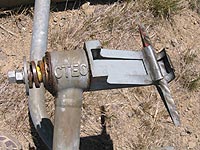 |
The
mechanism by which the carrier is attached to the haul rope.
Grips can be either fixed, meaning that the grip is clamped
into a precise location and remains there, or detachable,
meaning that the grip contains a complex system of springs
and clamps which allow it to be automatically attached or
detached to the haul rope in the terminals. |
Handle
Tow
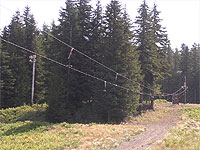 |
A
modern variant of the rope tow, which uses a thin wire rope
(under high tension) and plastic handles, which skiers and
riders hold on to while being towed up the hill. |
Haul
Rope
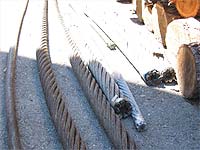 |
A
wire rope which moves the carrier up the hill. In modern
monocable design, it also supports the weight of a carrier
and its passengers. |
High
Speed Quad
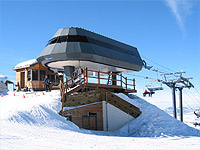 |
Generally
used interchangeably with detachable quad. A quad chairlift
with carriers which detach and slow for loading, reattaching
them so that they can travel faster than a fixed-grip quad.
There are at least two high-speed quads at each American
Skiing Company resort. |
Hold
down assembly
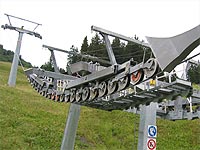 |
An
assembly of sheaves that hold down the haul rope. Also called
depression assembly. |
In-Line
Tower
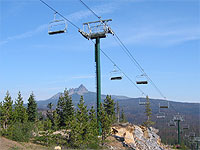 |
Any
lift tower which is not also a drive or return terminal.
Towers are typically numbered, which makes them handy landmarks. |
J-Bar
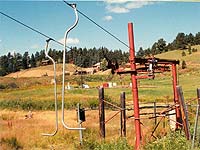 |
A
type of surface lift created in the '40s. J-Bars hang
from wire ropes which are suspended by towers. A metal
tube hangs down from the grip, and ends in either a horizontal
or slightly curved appendage at the bottom (hence the
"J"). Skiers place the horizontal appendage
under their butts and get towed up the hill. Sitting down
on a J-Bar virtually guarantees falling off the lift.
There are still a few J-Bars around today, although they're
quite rare.
Picture thanks to Colorado Ski History Museum. |
Jigback
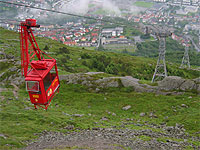 |
Any
type of lift with just two carriers that counterbalance
each other. One carrier goes up while the other goes down,
and vice versa. Jigback lifts include Funiculars and Trams. |
Lift
Frame
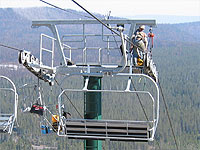 |
The
superstructure on top of an in-line tower, to which mechanics
can attach a device to hoist the haul rope for maintenance
or repair purposes. |
Line
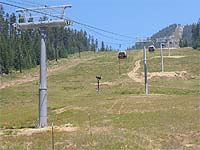 |
A
broad term for the area of the lift between the terminals,
including the inline towers, the tower heads and the sheave
trains. |
| Line
Check |
An
inspection of the line of the lift by ski area personnel,
done by riding the lift. On the line check, the inspector
observes the behavior of the lift and looks and listens
carefully to each tower, to ensure that everything is functioning
properly. |
| Line
Speed |
The
speed at which a haul rope travels. A fixed grip chairlift
usually has a line speed of between 400 and 500 feet per
minute; Poma lifts can approach 700 feet per minute, and
modern detachable lifts can travel more than 1,000 feet
per minute. |
Loading
Area
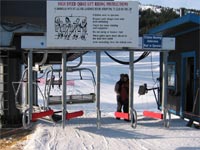 |
The
area between the lift maze and the lift portal (the last
stage of the load terminal before you're out on the line).
There's lots going on in the loading area - pay attention
to what's going on around you! |
Load
Line
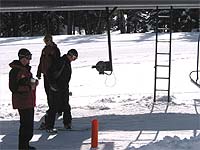 |
A line, designated either by signs on either side or by
a board placed in the snow, on along which all passengers
loading a chair should be aligned just before boarding a
chairlift or surface lift. Having everyone evenly aligned
makes it easier for the lift operator to give everyone a
smooth load. |
Load
Test
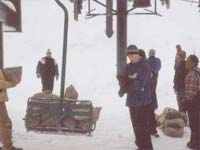 |
The
process by which ski areas and state lift inspectors test
lifts to ensure that they're cabable of running in accordance
with design parameters. Typically, boxes lined with trash
bags are placed in chairs and filled with water to a point
where the lift is loaded with more weight than it would
typically sustain in normal operation. The lift's capacity
to start, stop and prevent a rollback is then evaluated.
Every new lift undergoes a load test prior to being put
into service, and all aerial lifts are load tested periodically
according to the tramway laws in their state. |
Maze
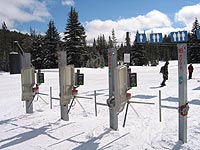 |
The area in which skiers and snowboarders gather while waiting
to board a lift. Mazes are designed to optimize chairlift
loading. Skiers and riders often call mazes "lift lines." |
Magic
Carpet
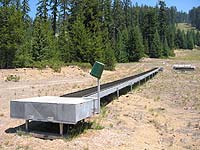 |
A
brand name for a type of surface lift which is rather like
a conveyor belt. Skiers and snowboarders simply step onto
the surface, which is a continuous belt. Magic Carpets are
more typically found in children's areas, but some ski areas
also use them for beginning adults. |
Midstation
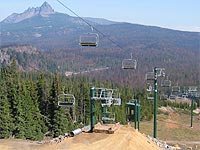 |
A
structure somewhere on the line of the lift, between the
top and bottom terminals, which allows skiers to either
load, unload or both. |
Offset
Tower
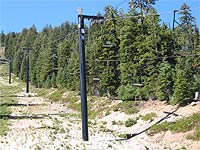 |
A tower that is offset from the normal center-line of the lift. The offset can help by providing a wider run for the skier. The tower cross arm is normally missing the down-line assembly. The lack of an assembly helps the manufacturer reduce costs. Also the larger down-line span helps absorb the energy generated by stops and starts in a lift with a fixed carriage. |
Pomalift
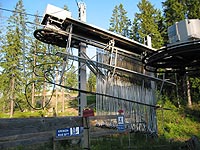 |
A
type of surface lift invented by French engineer Jean Pomagalski..
Like T-Bars and J-Bars, the Pomalift utilizes an overhead
cable suspended by towers, from which metal bars descended.
But unlike T-Bars and J-Bars, which pulled passengers up
the hill by means of a bar placed under their butts, a Pomalift
stick has a six-inch plastic disc at the bottom. The stick
is placed between the skier's legs (Pomalifts are a dismal
experience on a snowboard), with the disc under the butt.
Pomalifts were in many regards the first widely-used detachable
lifts; the sticks stop in the bottom terminal, and the grips
are designed in such a way that the haul rope runs freely
through them while the Poma stick awaits its next passenger.
Once the skier is at the load line, the operator hands the
skier the stick, then trips a lever which kicks the Poma
stick forward. This action and the skier's weight creates
a slight kink in the haul rope, which results in sufficient
friction within the grip to allow the stick and disc to
pull the skier uphill. There are also fixed-grip versions,
often called platter pulls. Except for fixed-grip versions
found in beginner areas, Pomalifts tend to be quite fast
- faster, in fact, than fixed grip chairlifts. They're still
quite common in Europe, but they never really caught on
in the US, although there are still a few around. Jean Pomagalski
went on to found the Poma Lift Company, which is still one
of the major manufacturers of modern lifts in the world
today. The company was recently sold to Leitner, another
lift company. |
Portal,
Portal Area
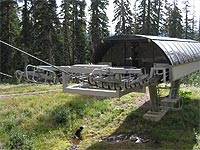 |
The
area between the legs of the uphill end of a bottom terminal. |
Prime
mover
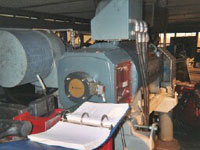 |
The
motor that is the primary mover of the lift. It can be gas,
diesel or electric. It may not necessarily be the motor
with the highest horsepower. |
Pulse
Lift
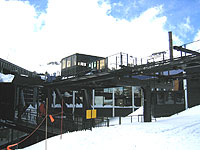 |
A
type of aerial lift most commonly seen in Europe. Pulse
lifts feature widely-spaced series of carriers - typically,
gondola-type cars -- permanently gripped together in a train.
The lift must stop at the terminals (hence the term "pulse")
to load and unload. These are comparatively low-capacity
lifts and are rarely built today. |
Retention
Bar
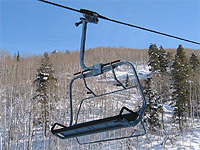 |
A device which can be lowered to help retain skiers and
snowboarders in the chair on a chairlift. The presence of
Retention Bars on chairlifts - and their use by passengers
- is required by law in some states, including those in
New England. They are not required by law in others, including
Colorado, Utah and California, although they're found on
may lifts in those states. |
Return
(or Return Terminal)
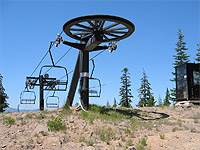 |
The
terminal at the other end of the lift from the drive terminal. |
Rime
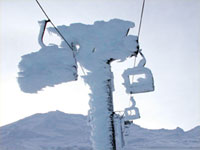 |
The
formation and buildup of ice on a lift. This can take many
hours to get the lift moving properly again. |
Rope
Position Detector
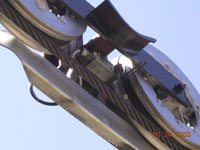 |
Another
type of safety device used on some lifts to ensure that
the haul rope is properly aligned. They're essentially metal
detectors, and can detect movements in the haul rope of
as little as _ inch. In the United States, they're required
on all aerial lifts which travel more than 600 feet per
minute. |
Rope
Tow
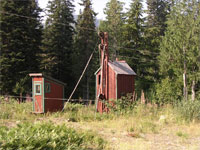 |
Although winter sports enthusiasts had used trains, funiculars
and other forms of conveyance in the Alps to ascend mountains
earlier, the rope tow was the first true uphill conveyance
designed specifically for skiing. Essentially a large diameter
rope spliced together at both ends, the rope tow was powered
by an engine or motor (early ones used car axles), which
pulls the rope uphill. On the downhill side, the rope was
typically held off the ground by means of wheels (often
automotive tire rims) attached to towers (typically worn-out
telephone poles). A low-tension device, the rope runs along
the ground until a skier picks it up. Early rope tows used
natural fiber ropes, which picked up water and made them
both heavy and slippery. More recent ropes for rope tows
are synthetic fibers. There are still a few rope tows around;
they're more likely to be found at small and community ski
slopes. |
| Rotation |
Left-hand-up:
Rotation of the lift will have the up-line on the left side
as you face up hill. Also called left-hand.
Right-hand-up: Rotation of the lift
will have the up-line on right side as you face up the hill.
Also called right-hand. |
Safety
Gate
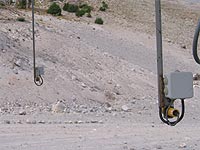 |
A
device - usually a rope, metal bar or laser - at the top
of lifts, hooked into the lift's safety circuitry. If a
skier or snowboarder fails to unload properly, they'll trip
the rope or bar, which throws a switch and stops the lift.
If you ever have trouble getting off a lift, do NOT try
to avoid this device - blast through it bravely, knowing
that your troubles are nearly over! |
Sheave
loads
|
Weight
is controlled by design/code loads. Typically the average
is not more than 500 lbs. per sheave. As loads approach
250 to 0 lbs. a compression assembly is used. If loads exceed
500 lbs. - more sheaves per assembly and or larger diameter
sheaves are used. If negative loads are required, hold down
assemblies are used. Some hold down assemblies are support
assemblies turned upside down. Minimum loads on sheaves
are needed to counteract side loads such as swinging carriers
and wind. |
Sheave
Train
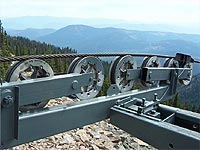 |
A
series of sheave wheels, located on the crossarm of an in-line,
top or bottom terminal. They're typically mounted in assemblies
known as "Walking Beams," which allow the wheels
to move up or down in response to the weight of the carrier
and its passengers. |
Sheave
Wheel
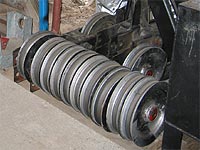 |
A
metal wheel, lined with a special type of rubber, which
either supports or depresses the haul rope. |
Six-Pack
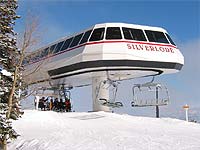 |
A
six-passenger high speed chairlift. Some lift companies
are now making 8-passenger high speed chairlifts. |
| Slope
Length |
The
linear distance covered by a lift. Think back on right triangles
from your high school trigonometry class: the vertical rise
of the lift is the vertical leg of a triangle, and the slope
length is the hypotenuse. |
Spacer
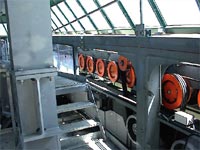 |
A
device on modern detachable lifts (gondolas and high speed
chairlifts) which can advance or retard the speed a carrier
as it moves through a terminal, in order to keep the proper
distance between carriers. |
Splice
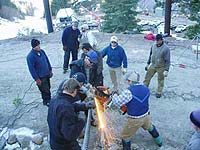 |
The process of weaving one end of a rope smoothly into the
other in order to create a continuous loop. Also: the area
of a haul rope which has undergone a splice. The splice
on a modern lift is generally about 120' in length. |
Support
Assemblies
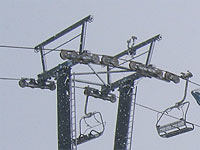 |
An
assembly of sheaves that hold up the haul rope from the
bottom side. Also called breakover assembly. |
Support
Tower
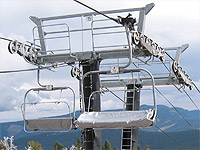 |
An
in-line tower on which the sheave train supports the haul
rope, rather than depressing it. |
Surface
Lift
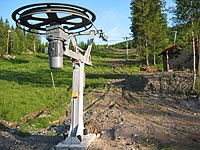 |
Any
lift on which the skier or snowboarder's skis or board remains
in contact with the snow. Surface lift types include Rope
Tows, Handle Tows, J-Bars, T-Bars and Poma Lifts. |
T-Bar
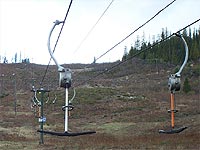 |
A surface lift similar in design and concept to a J-Bar,
only with a T-shaped fitting at the bottom to allow two
skiers to ride side by side. The device essentially tows
you up the hill, and sitting down on it is always a mistake.
Getting your boot buckles tangled with those of the person
riding next to you is always interesting. Tall adults riding
with small children have even more fun. |
Tensioning
System
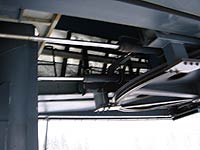 |
A device which keeps correct amount of tension on the
haul rope - and therefore, the appropriate amount of friction
between the haul rope and the wheel. Many new lifts are
tensioned by either pneumatic or hydraulic tensioning
systems instead of counterweights.
Also
see counter weight. |
Terminal
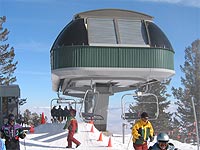 |
Generally,
the structures at the top and bottom of the lift, where
skiers and riders load and disembark. Some lifts, such as
multi-stage gondolas, also use in-line terminals or mid-stations. |
Terminal
Speed
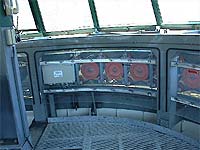 |
The speed at which a carrier goes through a terminal. On
a fixed grip lift, terminal speed is the same as line speed.
On a detachable lift, it's slower. |
Tower
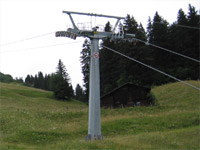 |
Any structure which either supports or compresses the haul
rope. Most towers today are "tubes," or pipe.
Towers on older lifts, and also very tall towers such as
those used on trams, are typically constructed in lattice
fashion. Towers are anchored to massive blocks of concrete,
which are either buried in soil or pinned to rock. Lift
manufacturers and ski areas also consider the terminals
at either end of a lift to be towers. |
Tower
Head
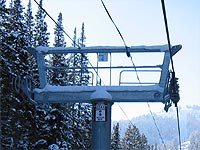 |
The
assembly at the top of the vertical portion of a tower,
including the cross arm, the sheave trains and the lift
frame. |
Track
Rope
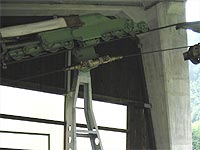 |
A
smooth wire rope with the sole function of supporting a
carrier. The carrier rides along the track rope on small
wheels, which wrap around it. Lifts which have track ropes
also have haul ropes to move the carrier. Track ropes are
found on older-style (non-monocable) gondolas and aerial
tramways. |
Tram
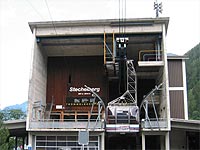 |
Webster's
defines "tram" as "the carriage of an overhead
conveyance;" technically, gondolas and chairlifts are
trams. But skiers typically use the term to describe large
"jigback" style aerial lifts - which look rather
like aerial buses. Modern trams are generally used in areas
in which terrain limits the ability to place in-line towers
- either for topographic reasons (such as large cliffs)
or to span environmentally sensitive areas. There's a tram
in New York City which spans the East River and connects
Manhattan with Roosevelt Island. Trams are invariably supported
by track ropes and moved by means of haul ropes. While their
cabins can be quite large - there are double-decker trams
in Europe which can hold more than 200 passengers - the
fact that there are only two carriers limits their overall
hourly capacity. Despite this, they're remarkably energy
efficient; the two carriers counterbalance each other, just
as with a funicular. The tram in Palm Springs, California,
a massive lift which rises nearly a vertical mile over a
length of just over two miles, needs only a few hundred
horsepower to operate. |
Unload
Area
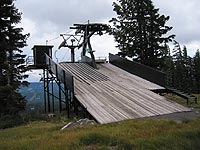 |
This
is the area located from the unload point of a lift and
down the ramp to a safe distance away, so the next passengers
can safely disembark. Always move quickly out of an unload
area. |
Up-line
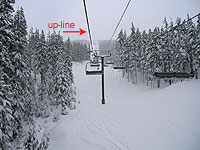 |
The side of the lift that the haul rope goes up the hill. |
Vertical
Rise
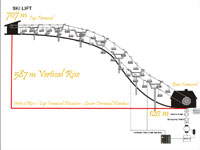 |
The
difference between the elevation at grade at the bottom
terminal and the elevation at grade at the top terminal. |
| VTFH
(Vertical Transport Feet per Hour) |
A technical term used by lift manufacturers and some ski
areas to describe a given lift's capacity. Essentially,
it refers to the vertical rise of the lift times the number
of persons who can ride it in one hour. For example, a
high-speed quad which has a vertical rise of 1000 feet
and an hourly capacity of 3000 has 3 million VTFH.
|
| Wire
Rope |
A replacement for hemp rope, see haul rope. |











































































